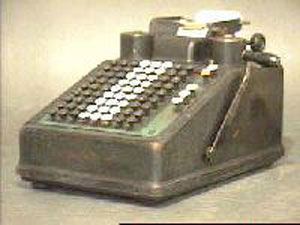|
Started
with the use
|
 |
|
Daverman's was able to locate an Electric
to perform the additions |
 |
|
were in order, that is, cost estimates etc. Daverman's then brought in the
FRIDEN
Now this was truly an amazing machine, noisy too. |
 |
|
Started
with the use
|
 |
|
Daverman's was able to locate an Electric
to perform the additions |
 |
|
were in order, that is, cost estimates etc. Daverman's then brought in the
FRIDEN
Now this was truly an amazing machine, noisy too. |
 |
|
The Friden Calculating Machine Co., Inc., was founded in the 1930's by Swedish born Carl M. Friden. Once customers purchased and started using the machines, Friden calculators quickly gained the reputation of being the 'Cadillac' of calculators. In fact, early Friden advertising literature self proclaimed the machines as the "Aristocrat of Calculators". The precursor to the STW was the model ST. The ST could automatically perform all four math functions. Friden, the perfectionist that he was, was personally involved in the mechanical design aspects of his machines. As a result of his skills and dedication, along with other gifted mechanical engineers that he hired on at Friden, they ended up with a machine that was fast, extremely durable, reliable, and easy to use. The ST was a very successful seller, and enjoyed a long production run which lasted through World War II. After the war, a refined version of the ST was created, and re-introduced as the STW in 1949. There were some feature and cosmetic changes (most notably changes in colors used to minimize user fatigue) from the ST to the STW, but the internal workings were virtually the same as the ST. The STW was immensely popular, and because of its popularity, it remained in production through 1966. In 1965, Friden introduced the world to all-electronic, transistorized calculators with the Friden EC-130 which marked the beginning of the end of Friden's mechanical calculators. Back in the days where electronic computers were in their infancy, the common method of performing large scale mathematics was to have large rooms full of 'computers' (back in those days, a 'computer' was a person who's job it was to perform math operations), each having their own mechanical or electro-mechanical calculator. Insurance companies were one of the biggest users of these hybrid human/machine 'computers', generating the actuarial tables that determine the rate paid by policy holders for life, auto, and business insurance. Friden electromechanical calculators were a common fixture in such installations because of their rock solid reliability. |